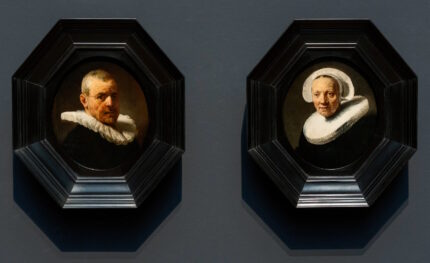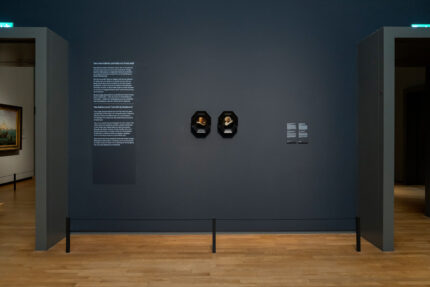
The subjects are Jan Willemsz van der Pluym, a wealthy slater and plumber in Leiden, and his wife Jaapgen Caerlsdr. They were 69 and 70 years old respectively in 1635 when the 29-year-old Rembrandt painted them. He was the top portraitist in Amsterdam at that time. Wealthy burghers paid huge sums to be immortalized by the most sought-after artist in the city. The wedding portraits of Marten Soolmans and Oopjen Coppit, now co-owned by France and the Netherlands, were the only life-sized, full-length portraits Rembrandt ever painted. The 19.9cm-by-16.5cm oval portraits of Jan and Jaapgen are the smallest portraits he ever painted.
Experts believe he may have painted them as a favor because Jan and Jaapgen were family friends and relatives by marriage. They were visiting Amsterdam for a baptism at that time and Jonathan Bikker, the Rijksmuseum’s curator of 17th-century Dutch painting, believes he may have asked Rembrandt to scare up a couple of portraits right quick which he would then make large copies of later.
The van der Pluyms had a close bond with Rembrandt’s family, which began in 1624 when Jan and Jaapgen’s son Dominicus wed Rembrandt’s cousin Cornelia Cornelisdr van Suytbroek. Suspicions that the portraits were by Rembrandt’s hand were confirmed after extensive technical research conducted by the Rijksmuseum using X-radiography, infrared photography, infrared reflectography, macro X-ray fluorescence (MA-XRF), stereomicroscopy and paint sample analysis. When taken together the various research results amount to compelling evidence. First of all, the bold and vigorous style used to render these portraits corresponds with Rembrandt’s rapid execution of other portraits and tronies from 1634 onwards. Similarly, the manner in which changes were made during the painting process is also consistent with other paintings by the artist. These alterations are visible in both collars and Jaapgen’s cap. Examination with a stereomicroscope revealed that the portraits were built up in a similar manner to other portraits painted by Rembrandt in this period. Moreover, the pigments match those frequently used by Rembrandt, including lead white, lead-tin yellow, bone- or ivory black, various earth pigments, vermilion and red lake. The same brown, iron-containing paint was used for both inscriptions, along with the signature and date on the portrait of Jan. The portraits also bear striking similarities regarding the buildup and composition of the paint compared to other portraits painted by Rembrandt in 1634 and 1635 – especially in the construction of the facial features and the loose brushwork.
The portraits remained in Jan and Jaapgen’s family until they were sold after the death of their great-great grandson Martenten Hove in 1760. They passed through a few titled hands after that, eventually being sold by James Murray, 1st Baron Glenlyon, at a Christie’s auction in 1824. The portraits entered a private UK collection after that sale and were unknown to scholars until a descendant decided to sell them.

The Rijksmuseum has the largest and most representative collection of Rembrandt paintings in the world. Given my close relationship with the museum and the fact that the team of experts has been conducting research into these portraits over a period of years, I feel that these works belong in the museum.
* This article was originally published here








No comments:
Post a Comment